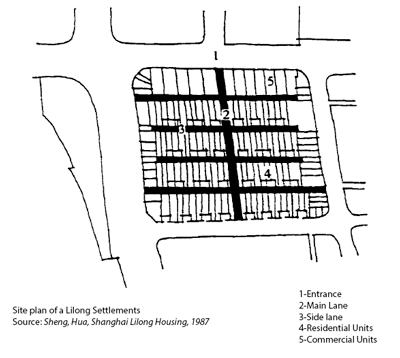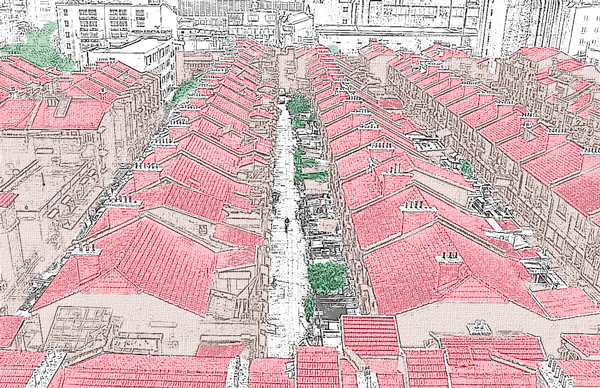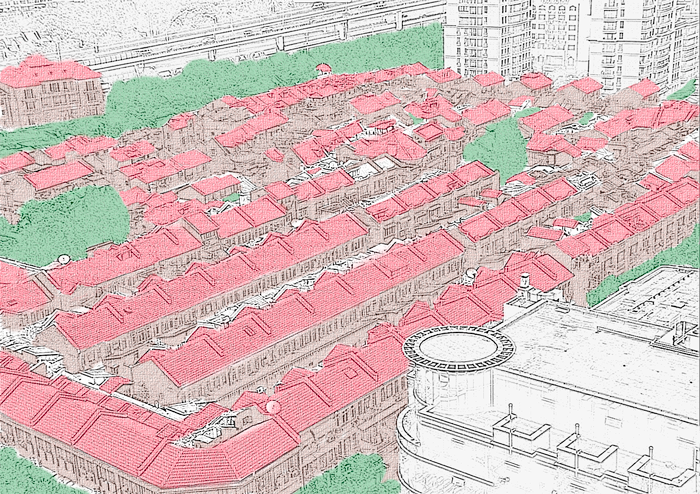"If you enter a longtang, you will find urinals, snack stalls, flies flying in hordes, children fighting in groups, fierce turbulences and sharp curses. What a disorderly small world!" This was what in 1933 Lu Xun wrote in his essay, "Children in Shanghai" to depict a longtang of the lowest class.
Walking Shanghai Lilong
"Looked down upon from the highest point in the city, Shanghai’s longtang—her vast neighbourhoods inside enclosed alleys—are a magnificent sight. The longtang are the backdrop of this city. Streets and buildings emerge around them in a series of dots and lines, like the subtle brushstrokes that bring life to the empty expanses of white paper in a traditional Chinese landscape painting. " This is the opening of Wang Anyi 1995 novel "Song of Everlasting Sorrow" (长恨歌).
According to what Wang describes in her novel, the longtang seem to embody the essence of Shanghai culture that has survived in spite of a brutal history, but is now about to vanish: "Amid the forest of new skyscrapers, these old longtang neighbourhoods are like a fleet of sunken ships, their battled hulls exposed as the sea dries up".
Lilong 里弄 is the Shanghai term for Longtang 弄堂 "lane houses" a group of houses that reflect the compositional layout of the Londoners' lane houses in the half of the nineteenth century seeing through the prism of the Chinese traditional housing.
Lilong: "Li" means neighbourhoods, "Long" means lanes. These two words are combined to describe an urban housing form which has characterized the city of Shanghai for 150 years. Being an integral part of the city growth from 1840 to 1949, Lilong settlements represented the majority of housing stock in the city centre until the end of the 20th century.
In 1963 the Communist Party's Shanghai committee defined Lilong: "the frontier posts for class struggle, the home front of production, places of living, and important battle positions for the struggle to foster the proletariat and destroy the bourgeoisie".
Longtang Structure
The Lilong settlement, as a low-rise, ground-related housing pattern, has many advantageous features: an hierarchical spatial organization network, the separation of public and private zones, a high degree of safety control, a strong sense of neighbourly interaction and social cohesiveness, and so on. These factors make the lilong neighbourhoods a pleasant place to live and hence they are loved by the local populace.
The whole settlement has a couple of main lanes, used as the major circulation passages, which are accessible from the commercial streets.
The side laws, leading to each housing units, connect to the main lanes. The clear, rational structure of a lilong settlement gives a high degree of secu rity and quietness to its internal living environment, contrary to its noisy urban surrounding dominated by commercial developments. The front housing units along the perimeter of a lilong settlement are generally converted to shops as well as some housing units inside the settlement, have also integrated small-scaled, home-based businesses to provide the daily amenities of the entire community.
rity and quietness to its internal living environment, contrary to its noisy urban surrounding dominated by commercial developments. The front housing units along the perimeter of a lilong settlement are generally converted to shops as well as some housing units inside the settlement, have also integrated small-scaled, home-based businesses to provide the daily amenities of the entire community.
Varying architectural types and different grades of residential homes served different social classes and evolved in time. The shikumen (Shikumen 石库门"Stone Warehouse Gate" is one of the housing styles of lilong) residences were originally built, after 1842 at the end of the first opium war, for prosperous families, foreign residents, white-collar workers, and middle-class residents, who were going to populate the new foreign concession after the Treaty of Nanking. But as the maintenance of the buildings fell into disrepair, population density increased, facilities became outmoded, buildings became increasingly makeshift, and living conditions worsened. Some neighbourhoods gradually degenerated to house society’s lower classes, and others became slums.
Longtang Evolution
As the forces of globalization sweep across the world, many cities, especially in developing countries, rush to catch up with the opportunity for their economic and social development; meanwhile they anxiously dismantle massive traditionally low-density communities to meet with the over-expanding housing demand and economic growth.
Since the economic reforms of 1990, people nationwide have surged into Shanghai for better job opportunities, which resulted in the housing crunch. To meet the explosive housing demand, the government approved the “sweep-out” reform policy to replace the low-density residences with grand, but inhospitable, high-rise dwellings. Then the urban heritage gradually dies out in the disordered urban fabric as a result of mass-produced housing projects.
Viewed from the architectural and urban cultural respects, it decreased the architectural diversity in this historic city, destroyed the original urban fabric and changed social lifestyle.
In general, living in a longtang is not free from problems: there is no privacy in the longtangs. Neighbours cook together, and usually eat dinner outside, where they can see what other families are eating, toilets and washrooms are shared, if there are quarrels between families, everyone in the neighbourhood gets involved. So people often prefer leaving their neighbourhood and moving to ‘modern’ houses but, they are often not aware of the big change is going to happen to their lives.
The historic and culturally influenced neighbourhood died out along with the traditional residences.
The errors being made in Shanghai, however, will be glaringly obvious to anyone who knows urban planning and development. After all, many of the mistakes that Shanghai is making are mistakes that North America and Europe pioneered.
The arising question now is, if it is possible to preserve the character of the traditional street life within the contemporary social models, of economic growth and higher density requirements. How can the public and private spaces of contemporary Shanghai communities be organized to reflect traditional street life that promotes interpersonal and community interaction?
Is the lilong unique fate to be turned into high-rise dwellings or Disney-like areas?
After years of large-scale demolition, especially in the occasion of the 2010 World Expo, when inhabitants from tens of thousands of longtang houses were moved to high-density areas in the city suburbs, the government suddenly started propagating lilong as representatives of a unique "Shanghai Culture", starting some programs of restoration.
After many controversial attempts, some different approaches emerged.
The reconstruction by preserving the “outer skin” of the residence, and while altering its structure and functions into commercial use as shops, bars and restaurants. With this approach, the monotonous function of use only preserves the skin of the residences, rather than the essence. An example of this solution is the "Shanghai Xintiandi project". "Xintiandi today, is preserving nothing more than a shell, [] the life that once made this place really interesting is gone, perhaps forever", says Wang Anyi.
As the Lilong houses may vary from poor to luxury buildings, in presence of high value architecture like in "Citè Bourgogne" in the French Concession, the restoration was aimed to preserve its residential quality, but the cohabitation of different, unintegrated social groups, prevents the creation of a real social community.
Transform the Lilong houses into Creative Art Park that includes galleries, artist studios, art shops and coffee shops, while the rest of the community is preserved for the residential use as in the "Tianzifang project", is a third kind of approach. Even in this case, the original aim of the Lilong community is destroyed and the large flow of tourism and night life has caused many controversy with the surrounding neighbourhoods, leading the local community into social conflict and chaos.
However this 'bottom-up' approach coming through the initiative of the neighbourhood committees is definitely better than 'top-down' projects like Xintiandi, the result of political and economic interests of the upper-class.
The Theme
Finally, and here we are at the theme of my reportage, the Shanghai municipality allocated some of these traditional-style housings, so called “Model Quarters” (文明小区) to rather poor city dwellers connected with a redevelopment program and providing a minimum of facilities.
I am personally convinced that this project represents an interesting compromise, but the precariousness of the existing living standard and the pressure of large economic interests related to the intensive exploitation of the territory, make the survival of these settlements really uncertain.
My work is focused on some vital and active “Model Quarters” Lilong in the Huangpu district, located around Huangpi (黄陂南路) , south of the Xintiandi Metro Station (新天地) between Huahai Road (淮海中路) and Zhao Zhou Road (肇周路).Here, I’m trying to offer a naive view of the social environment and lifestyle in this relatively poor, but quiet and pleasant place (even if extremely chaotic), where it is still clearly recognizable a high level of social cohesion, the presence of basic services and facilities, even if in a really humble context.
The tour starts from the external lanes surrounding the lilong, where commercial sites, public spaces and services are located and then ideally goes to the hearth of the neighbourhood.Then following the main and side lanes to meet the people and places where they eat, sleep, chat, play, in short, live and finally return to the crowded and noisy streets.
The photographs do not show beautiful old Western-style buildings, embassies, elegant residences, nor public architecture and monuments, nor pleasant gardens.None of the symbols of the luxurious colonial past or the futuristic buildings of the twenty-first century, Shanghai.
These images are just fragments of ordinary daily life; work, amusements and boredom. The anticipation of nostalgia for things that are doomed to disappear.To conclude with Wang Anyi own words:
